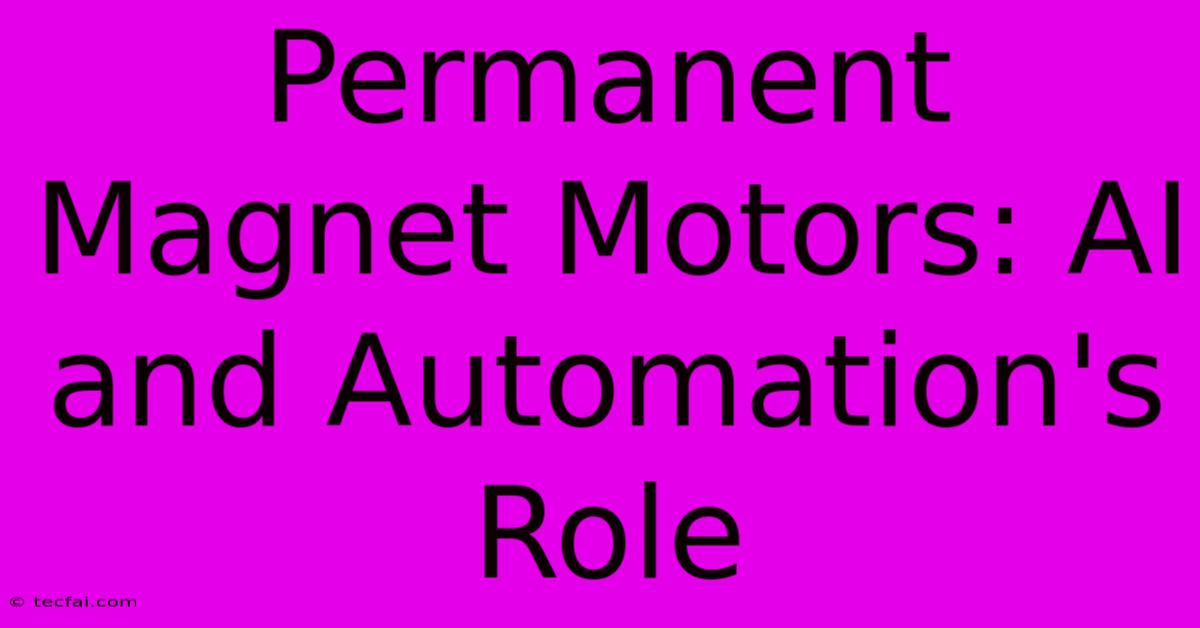Permanent Magnet Motors: AI And Automation's Role

Discover more detailed and exciting information on our website. Click the link below to start your adventure: Visit Best Website tecfai.com. Don't miss out!
Table of Contents
Permanent Magnet Motors: AI and Automation's Role
Permanent magnet motors (PMMs) are ubiquitous in modern applications, from electric vehicles and industrial automation to robotics and consumer electronics. Their efficiency, high power density, and relatively simple design make them a cornerstone of many technological advancements. However, the continued optimization and innovative application of PMMs are increasingly reliant on the power of artificial intelligence (AI) and automation. This article delves into the crucial role AI and automation play in revolutionizing the design, manufacturing, and control of permanent magnet motors.
AI-Driven Design Optimization
The design of a high-performance PMM involves numerous complex variables, including magnet type, winding configuration, stator and rotor geometry, and cooling system. Traditional design methods often rely on iterative trial-and-error, a time-consuming and potentially inefficient process. AI, specifically machine learning (ML) algorithms, offers a powerful alternative.
ML for Predictive Modeling:
ML models can be trained on vast datasets of existing PMM designs and their corresponding performance characteristics. This allows the AI to predict the performance of new designs with remarkable accuracy, significantly reducing the need for physical prototyping. Predictive modeling accelerates the design cycle and helps engineers explore a wider range of design possibilities.
Genetic Algorithms and Evolutionary Optimization:
Genetic algorithms, a type of evolutionary algorithm, are particularly well-suited for PMM optimization. These algorithms mimic the process of natural selection, iteratively refining designs based on performance metrics such as efficiency, torque, and power density. This approach can uncover novel and highly optimized designs that might be missed by traditional methods.
Automation in PMM Manufacturing
The manufacturing of PMMs, especially at scale, requires precision and efficiency. Automation plays a crucial role in ensuring consistent quality and reducing production costs.
Robotic Assembly and Handling:
Robots are increasingly used in PMM assembly, performing tasks such as winding insertion, stator stacking, and rotor assembly with greater speed and accuracy than human workers. This reduces human error and increases throughput.
Automated Quality Control:
Automated inspection systems utilizing computer vision and other sensing technologies are employed to detect defects in PMMs during the manufacturing process. This ensures that only high-quality motors leave the production line, minimizing costly recalls and improving overall product reliability.
Predictive Maintenance through AI:
AI-powered predictive maintenance systems can analyze data from sensors embedded in manufacturing equipment to predict potential failures. This allows for proactive maintenance, minimizing downtime and ensuring consistent production.
AI-Enhanced Control and Monitoring
Once a PMM is in operation, AI continues to play a crucial role in optimizing its performance and extending its lifespan.
Real-Time Performance Optimization:
AI algorithms can analyze real-time data from motor sensors (temperature, current, speed, etc.) to adjust control parameters dynamically, optimizing efficiency and performance under varying operating conditions. This leads to improved energy efficiency and reduced wear and tear.
Fault Detection and Diagnostics:
AI-powered systems can detect anomalies in motor behavior that indicate potential faults. This early detection allows for timely maintenance or repairs, preventing catastrophic failures and extending the motor's lifespan.
The Future of Permanent Magnet Motors and AI
The integration of AI and automation is transforming the entire lifecycle of permanent magnet motors, from design and manufacturing to operation and maintenance. As AI algorithms become more sophisticated and computational power continues to increase, we can expect even more significant advancements in PMM technology. This includes the development of more efficient, powerful, and reliable motors that will play a crucial role in the ongoing transition to a more sustainable and automated future. The synergistic relationship between PMMs and AI is poised to drive innovation across numerous industries for years to come.

Thank you for visiting our website wich cover about Permanent Magnet Motors: AI And Automation's Role. We hope the information provided has been useful to you. Feel free to contact us if you have any questions or need further assistance. See you next time and dont miss to bookmark.
Featured Posts
-
Mortgage Rate Cuts Barclays Metro Rental Cap Removed
Nov 27, 2024
-
Nzd Usd Tumbles On Tariffs
Nov 27, 2024
-
Stanfords Bhattacharya New Nih Director
Nov 27, 2024
-
Rohl On Wednesdays Crucial Push
Nov 27, 2024
-
Shark Eats Diver Then Releases
Nov 27, 2024
